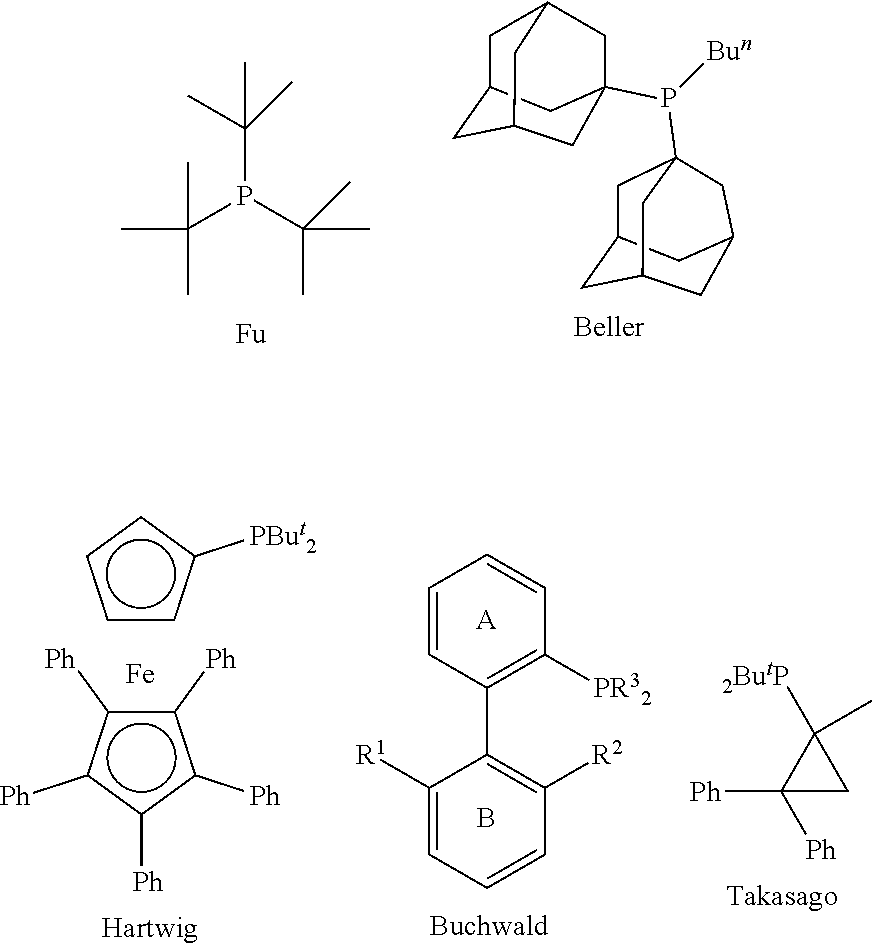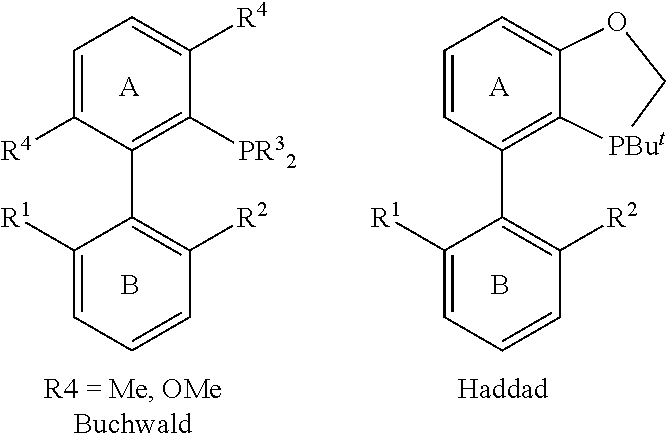Triaryl phosphine ligands, preparation method therefor, and use in catalysing coupling reactions
a triaryl phosphine and phosphine technology, applied in the preparation of amino compounds, physical/chemical process catalysts, organic compounds/hydrides/coordination complexes, etc., can solve the problem that the phenyl group on the side of the phosphorus atom cannot avoid the defect, the introduction of methyl or methoxy groups still fails to completely compensate, and the synthesis step is more than 10 steps long
- Summary
- Abstract
- Description
- Claims
- Application Information
AI Technical Summary
Benefits of technology
Problems solved by technology
Method used
Image
Examples
example 1-1
[0104]To an oven-dried 250 mL flask, equipped with a magnetic stir bar and a condenser, was charged with magnesium (0.29 g, 12.0 mmol), THE (10 mL) and bromobenzene (1.73 g, 11.0 mmol) heated to reflux for 2 h to obtain a Grignard reagent.
[0105]To another oven-dried two-neck 250 mL flask was added THE (15 mL) and 3,5-dichlorotoluene (0.81 g, 5.0 mmol), n-butyllithium (2.4 mL of a 2.5 M solution in hexanes, 6.0 mmol) was added dropwise at −78° C. and stirred for 30 min. At that point the Grignard reagent was transferred via cannula to the solution, then warmed to room temperature, and the reaction solution was heated to 80° C. for 6 h. Cooled to −78° C. again, then Ph2PCl (1.32 g, 6.0 mmol) was added dropwise via cannula and the solution was warmed to room temperature for 6 h. The solvent was a removed in vacuum and 50 mL of brine was added, and the mixture was extract with dichloromethane three times (3×40 mL), and the combined organic phase was washed with brine, dried over anhydro...
example 1-2
[0109]To an oven-dried 100 mL flask, equipped with a magnetic stir bar and a condenser, was charged with 2,6-diphenyl-4-methyliodobenzene (0.74 g, 2.0 mmol) and THE (3.0 mL) under nitrogen atmosphere. Cooled to −78° C., 0.89 mL n-butyllithium (2.7 M solution in hexanes, 2.4 mmol) was added dropwise in about 8 min, and the solution was reacted for 2 h. Then Ph2PCl (0.44 g, 2.0 mmol) was added dropwise via cannula and the solution was warmed to room temperature for 6 h. The solvent was a removed in vacuum and 20 mL of brine was added, then the mixture was extracted with dichloromethane (3×20 mL), and the combined organic phase was washed with brine, dried over anhydrous sodium sulfate and concentrated in vacuum to give a light yellow oil. The residue was purified by column chromatography to give 0.60 g of (2,6-disphenyl-4-methylphenyl)-diphenylphosphine as a white crystalline material (71% of yield).
example 1-3
[0110]To an oven-dried 50 mL flask, equipped with a magnetic stir bar and a condenser, was charged with magnesium (0.06 g, 2.2 mmol), and THE (5 mL), and 2,6-diphenyl-4-methyliodobenzene (0.74 g, 2.0 mmol) was added and the mixture was heated to reflux for 2 h to obtain a Grignard reagent. Then Ph2PCl (1.32 g, 6.0 mmol) was added dropwise via cannula at −78° C. and the solution was warmed to room temperature for 6 h. The solvent was a removed in vacuum and 20 mL of brine was added, then the mixture was extracted with dichloromethane three times (3×20 mL), and the combined organic phase was washed with brine, dried over anhydrous sodium sulfate and concentrated in vacuum to give a light yellow oil. The residue was purified by column chromatography to give 0.60 g of (2,6-disphenyl-4-methylphenyl)-diphenylphosphine as a white crystalline material, 69% yield.
PUM
 Login to View More
Login to View More Abstract
Description
Claims
Application Information
 Login to View More
Login to View More - R&D
- Intellectual Property
- Life Sciences
- Materials
- Tech Scout
- Unparalleled Data Quality
- Higher Quality Content
- 60% Fewer Hallucinations
Browse by: Latest US Patents, China's latest patents, Technical Efficacy Thesaurus, Application Domain, Technology Topic, Popular Technical Reports.
© 2025 PatSnap. All rights reserved.Legal|Privacy policy|Modern Slavery Act Transparency Statement|Sitemap|About US| Contact US: help@patsnap.com



